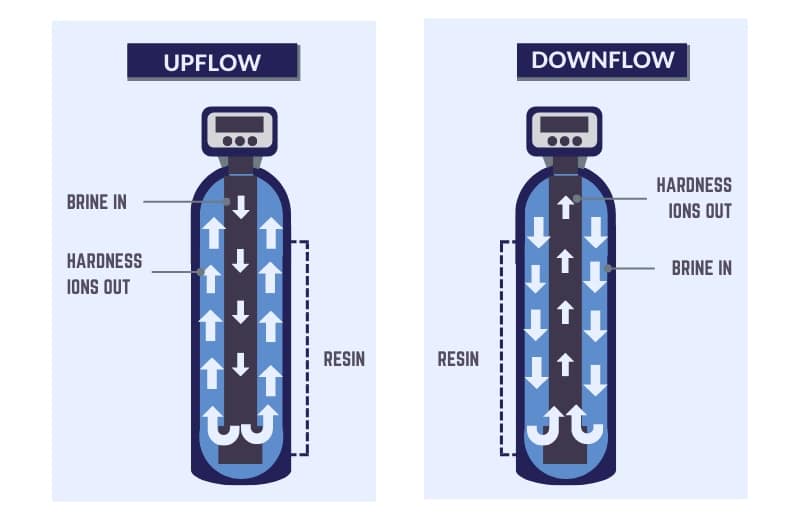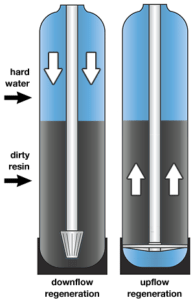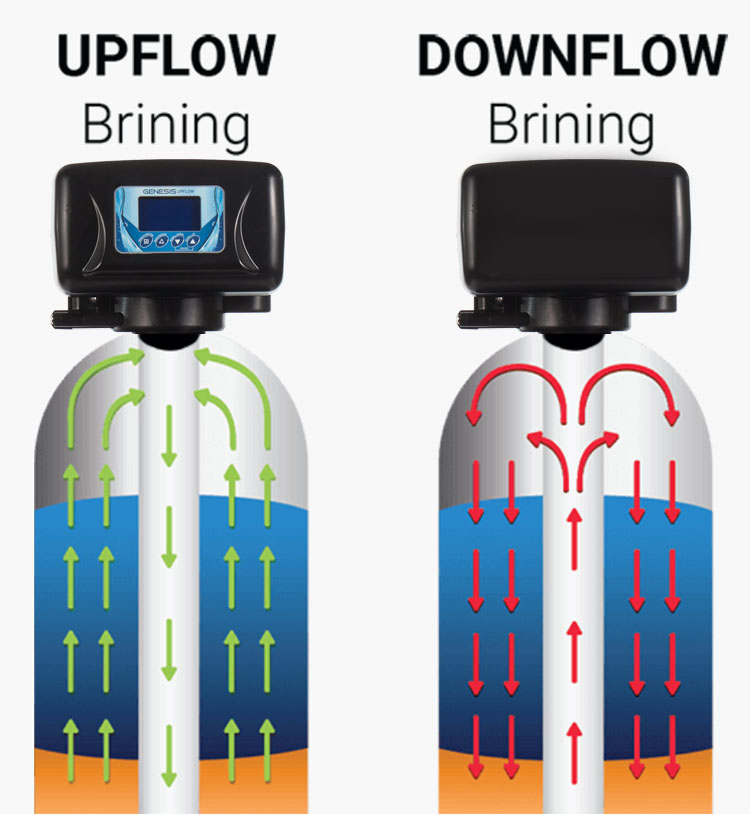Are you tired of dealing with hard water problems in your home? Whether it’s those stubborn spots on your dishes or the dullness of your laundry, hard water can be a real nuisance.
That’s where water softeners come into play, and choosing the right one can make all the difference. You might have heard about upflow and downflow water softeners, but which one is right for you? This decision can impact not only your household chores but also your wallet.
By the end of this article, you will not only understand the differences between upflow and downflow systems but also discover which option aligns perfectly with your needs. Let’s dive in and transform your water quality experience for the better!
What Is A Water Softener?
Have you ever wondered why your dishes come out spotty or your laundry feels stiff? It might be the hard water in your home. A water softener is the unsung hero that can transform your daily chores. But what exactly does it do?
A water softener is a device designed to remove minerals like calcium and magnesium from your water. These minerals are the culprits behind hard water. Hard water can cause scale buildup in pipes, reduce the effectiveness of soap, and leave your skin feeling dry.
Think about how frustrating it is to scrub soap scum off shower doors or feel like your hair isn’t as clean as it should be. A water softener eliminates these problems by exchanging the hard minerals with softer ones, like sodium or potassium.
Why Should You Consider A Water Softener?
Imagine no longer battling with cloudy glassware or stiff clothes. A water softener can save you time and effort. It can also prolong the life of your appliances by preventing scale buildup. This means fewer repairs and replacements.
Do you enjoy a nice, hot shower? Softened water can make your skin feel smoother and your hair shinier. It’s a simple change that can improve your daily routine.
How Does It Work?
A water softener uses a process called ion exchange. Hard water passes through a resin bed where calcium and magnesium ions are swapped for sodium ions. The softened water is then ready for use.
This process might sound technical, but it’s happening seamlessly in the background. You won’t even notice it’s there—until you do, in the form of sparkling dishes and softer laundry.
Is It Worth The Investment?
You might ask yourself, “Is a water softener worth it?” Consider the cost of continuously buying cleaning products to combat hard water stains. Or the wear and tear on your appliances.
Upflow Vs Downflow Water Softener: Which One To Choose?
Now that you understand the benefits of a water softener, let’s dive into the options. Upflow and downflow water softeners serve the same purpose but operate differently.
Upflow models push water upward through the resin bed, ensuring more efficient ion exchange. This can lead to less waste and better performance.
Downflow models are more traditional, with water flowing downward. They are often simpler and cost-effective but may not be as efficient as upflow models.
Consider your needs and budget. Think about the size of your household and water usage. Your choice will depend on what you prioritize: efficiency or simplicity.
Are you ready to say goodbye to hard water headaches? Selecting the right water softener can make a big difference in your home.

Credit: atharvafood.com
How Water Softeners Work
Understanding how water softeners work can be a game-changer in maintaining your home’s plumbing and appliances. Hard water, filled with minerals like calcium and magnesium, can wreak havoc on pipes and machines. Water softeners help by removing these minerals, making your water gentle on everything it touches.
What Is Hard Water?
Hard water contains high levels of minerals. Calcium and magnesium are the main culprits. These minerals cause scale buildup, affecting plumbing and appliances.
How Ion Exchange Works
Ion exchange is the key process in water softening. Water passes through resin beads. These beads exchange hard minerals for sodium ions. This process makes the water soft and usable.
Regeneration Process Explained
After ion exchange, resin beads need cleaning. This cleaning is called regeneration. Salt water flushes out the hard minerals. The beads are refreshed and ready to soften more water.
Difference Between Upflow And Downflow Systems
Upflow systems push water upwards through resin beads. This method uses less salt and water. Downflow systems move water downwards. They are traditional but use more resources.
Benefits Of Using A Water Softener
Water softeners extend appliance life. They prevent scale buildup in pipes. Soft water also improves soap efficiency, leading to cleaner dishes and laundry.
Upflow Water Softener Basics
Upflow water softeners offer a unique approach to water treatment. They use upward water flow during the regeneration process. This type of system is gaining popularity due to its efficiency. Let’s explore how it works and what benefits it offers.
Core Mechanism
In an upflow water softener, water flows upward through the resin bed. This ensures even distribution and effective ion exchange. The upward flow helps prevent channeling. Channeling occurs when water creates pathways through the resin. This reduces the softener’s efficiency. Upflow design maintains consistent contact with the resin. This results in better softening performance.
Advantages
Upflow water softeners have several benefits. They use less salt and water during regeneration. This makes them more cost-effective and eco-friendly. The systems also extend the lifespan of the resin. By preventing channeling, the resin wears out less quickly. Furthermore, upflow softeners provide consistent water quality. Users enjoy improved water softness and taste.
Potential Drawbacks
These systems also have some downsides. Upflow softeners can be more expensive upfront. The initial investment may deter some buyers. Additionally, installation might require professional help. The complexity of setup can be challenging for some. Maintenance can also be more involved. Regular checks ensure the system functions efficiently.

Credit: www.discountwatersofteners.com
Downflow Water Softener Basics
When considering water softeners, understanding the basics can make all the difference in your decision-making process. Downflow water softeners are a popular choice for many households. But what makes them tick? Let’s dive into their core mechanism, advantages, and potential drawbacks to give you a clearer picture.
Core Mechanism
Downflow water softeners operate by directing water downward through the resin bed. The process is straightforward: hard water enters the top of the tank, moving down through the resin beads. These beads exchange calcium and magnesium ions with sodium ions, softening the water as it flows through.
Imagine pouring a jug of water into a funnel. The water flows down and interacts with the resin beads, effectively reducing hardness. This is the heart of the downflow system, ensuring your water is gentler on pipes and appliances.
Advantages
One key advantage of downflow water softeners is their simplicity. They’re easy to understand and maintain. You don’t need to be a tech wizard to keep them running smoothly.
They often come with an affordable price tag. This makes them accessible for many homeowners looking to soften their water without breaking the bank.
Also, if you’ve ever felt frustrated by complex settings on home appliances, the downflow system’s straightforward design can be a breath of fresh air.
Potential Drawbacks
Despite their benefits, downflow softeners aren’t without flaws. Regeneration can be less efficient. Water flows the same way during both regular use and regeneration, potentially wasting water and salt.
They may not be the best option for homes with high water hardness levels. If your water is extremely hard, you might find yourself using more salt than anticipated.
Think about your household needs: Is efficiency your top priority? If yes, the downflow model might not be the perfect fit. Consider your options carefully to ensure you’re choosing the right system for your home.
Have you used a downflow water softener before? Did it meet your expectations? Share your experiences in the comments below!
Performance Comparison
Choosing the right water softener impacts your daily water use. Two popular types are upflow and downflow systems. Each has its unique strengths. This section compares their performance. It focuses on efficiency, water usage, and salt consumption. Understanding these aspects helps in making an informed decision.
Efficiency
Upflow water softeners are known for their high efficiency. They direct water upwards, fully utilizing the resin bed. This means less waste and better ion exchange. Downflow systems, in contrast, push water downwards. This can lead to uneven resin use. As a result, they might regenerate more often. This could mean higher operational costs.
Water Usage
Water usage is a critical factor for softeners. Upflow models typically use less water. Their efficient design reduces the need for frequent backwashing. Downflow softeners use more water in comparison. They require more frequent regeneration cycles. This can affect your water bill over time.
Salt Consumption
Salt consumption is another key aspect to consider. Upflow systems often consume less salt. Their efficient regeneration process ensures minimal waste. Downflow softeners, however, may use more salt. They tend to regenerate more often due to their design. This could increase your salt expenses.
Cost Considerations
When deciding between an Upflow and a Downflow water softener, cost considerations can play a significant role in your decision-making process. It’s not just about the upfront cost; ongoing maintenance expenses can impact your budget over time. Understanding these elements can help you make a more informed choice. Let’s break down the costs associated with each option.
Initial Investment
The initial purchase price of a water softener is often the first factor you consider. Upflow water softeners tend to be more expensive upfront. They use advanced technology that promises efficient water usage and effective softening, but this comes at a higher initial cost.
Downflow water softeners, on the other hand, are typically more budget-friendly. They offer a simpler mechanism, which often means a lower starting price. If you’re watching your expenses closely, this could be a more appealing option.
Think about your long-term goals. Are you willing to invest more now for potential savings down the road? It’s crucial to weigh these initial costs with future benefits.
Maintenance Costs
Maintenance is an ongoing consideration that can affect your wallet. Upflow systems may require less frequent maintenance because of their efficient design. They use less salt and water, which could save you money over time.
However, when maintenance is needed, it might be pricier due to the complexity of the system. You might need professional help, adding to your expenses.
Downflow systems usually need more regular upkeep, including salt replenishment and cleaning. While each maintenance task might be cheaper, the frequency can add up. It’s essential to consider how hands-on you want to be with maintenance.
How do you prefer to manage costs—through a single upfront payment or regular smaller expenses? Your choice might reflect your financial strategy and comfort with ongoing maintenance tasks.
Installation And Maintenance
Choosing between upflow and downflow water softeners involves understanding installation and maintenance differences. Upflow models often require less salt and may be easier to maintain, while downflow systems are traditional and reliable. Consider your water hardness level to decide which suits your needs best.
Installing and maintaining a water softener can dramatically improve the quality of your water, but the process can vary significantly between upflow and downflow systems. Understanding these differences can help you choose the best option for your home. Let’s break down the key aspects of installation and maintenance for both types of water softeners.Ease Of Installation
Installing a water softener might seem daunting, but it doesn’t have to be. Upflow systems generally require a bit more expertise due to their advanced technology. They often need precise positioning to ensure optimal water flow, which might mean hiring a professional installer. On the other hand, downflow systems are typically more straightforward. Many homeowners find they can manage the installation themselves with basic plumbing skills. This simplicity can save you both time and money.Regular Maintenance Needs
Once your water softener is up and running, keeping it in good shape is crucial. Upflow systems often boast lower salt usage, which means less frequent refilling. This can be a significant advantage for busy households. However, downflow systems may require more regular attention. You might find yourself checking and refilling the salt reservoir more often. While this could seem like a hassle, it’s a small price to pay for consistently soft water. Have you ever found yourself frustrated with frequent maintenance tasks? Choosing the right system can make all the difference in your daily life. It’s worth considering how much time and effort you’re willing to invest in maintaining your water softener.Environmental Impact
Understanding the environmental impact of water softeners is crucial. Water softeners help reduce hard water problems. But their operations can affect the environment. Two common systems are upflow and downflow water softeners. Each has different impacts on the planet.
Eco-friendliness
Upflow water softeners are known for their eco-friendliness. They use less salt and water during the regeneration process. This means less waste is produced. It leads to a smaller environmental footprint. Downflow systems, on the other hand, often consume more resources. They flush out more brine and water. This can be less friendly to the environment.
Sustainability
Sustainability is a key factor in choosing a water softener. Upflow systems are often more sustainable. They have efficient designs that minimize resource usage. Less water and salt usage means less impact on natural resources. Downflow systems may not be as sustainable. They often require more frequent maintenance. This can lead to higher resource consumption over time.
Choosing The Right Softener
Choosing the right water softener for your home is a decision that can impact your daily life and the longevity of your appliances. Whether you’re considering an upflow or downflow water softener, understanding your specific needs is crucial. Let’s dive into some factors that can guide your decision.
Household Needs
Every household is unique. Consider how many people live in your home and how much water you typically use. A large family may require a softener with a higher capacity to ensure everyone gets soft water, especially during peak usage times.
Think about your lifestyle. If you have a busy household with frequent guests, a robust system might be necessary. On the other hand, a smaller household might benefit from a more compact and economical solution.
Consider your appliances. If you have high-end dishwashers and washing machines, a water softener can protect them from mineral buildup, potentially saving you money on repairs.
Regional Water Conditions
Your location plays a pivotal role in this decision. Different areas have varying water hardness levels. Some regions have incredibly hard water, which demands a more powerful softener to effectively treat it.
Check your local water report. Many cities provide a water quality report that includes hardness levels. This can be a helpful tool in understanding what kind of softener you need.
Ask neighbors about their experiences. They may offer insights into the effectiveness of different softeners in your area, helping you make an informed choice.
Choosing the right water softener is more than just picking a brand. It’s about fitting your household needs and adapting to your regional water conditions. What factors are most important to you? Could a water softener change your daily life?
Expert Recommendations
Choosing between upflow and downflow water softeners can be complex. Each type offers unique advantages. Understanding expert recommendations can simplify the decision. Professionals weigh several factors when advising on water softener systems.
Water Efficiency
Experts often recommend upflow water softeners for water efficiency. These systems use less water during regeneration. This makes them more environmentally friendly. They can lead to cost savings over time. Upflow models often require less salt. This further enhances their efficiency.
Downflow systems are easier to install. Experts note their simple design. They are often more straightforward for DIY enthusiasts. Maintenance is generally less frequent. This can be a plus for busy households. Simplicity in design often means fewer parts. This can reduce potential repair needs.
Performance And Water Quality
Upflow water softeners excel in performance. Experts highlight their ability to provide consistent water quality. They offer better iron and hardness removal. This leads to improved water quality. Many users notice a significant difference. Clothes feel softer. Dishes sparkle more.
Cost plays a vital role in expert recommendations. Downflow models usually have a lower upfront cost. This makes them attractive for budget-conscious buyers. Upflow systems, while pricier initially, can offer savings long-term. Their efficiency can reduce water and salt costs.

Credit: www.discountwatersofteners.com
Frequently Asked Questions
What Is An Upflow Water Softener?
An upflow water softener pushes water upward through resin. It uses less salt and water. Ideal for conserving resources.
How Does A Downflow Water Softener Work?
A downflow water softener pushes water downward through resin. It’s more common. Often more effective for heavy mineral removal.
Which Is Better For High Hardness Levels?
Downflow is better for high hardness levels. It efficiently removes heavy minerals. Upflow is more resource-efficient.
Is Upflow Easier To Maintain?
Yes, upflow requires less maintenance. It uses less salt and water. Ideal for eco-friendly households.
Which Softener Is More Cost-effective?
Upflow is more cost-effective long-term. It uses fewer resources. Initial costs might be similar to downflow.
Conclusion
Choosing between upflow and downflow water softeners depends on your needs. Upflow models offer efficient salt usage. They can save you money over time. Downflow models are simpler and often cheaper upfront. Consider your budget and water usage. Each type has benefits and drawbacks.
Think about space, installation, and maintenance. Also, consider your water hardness levels. The right choice will improve your water quality. Enjoy softer water and better appliances. Make an informed decision for your home. Your water, your choice.





